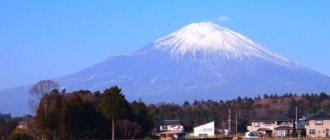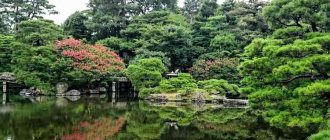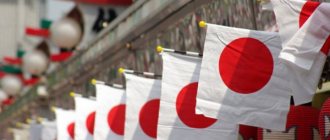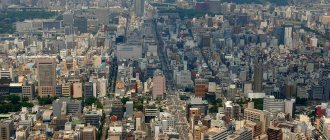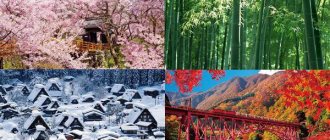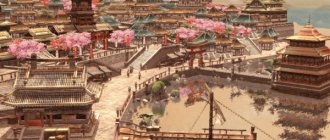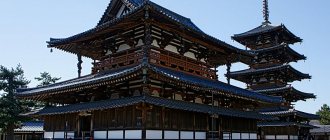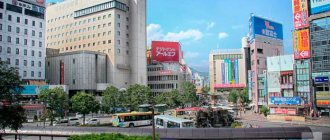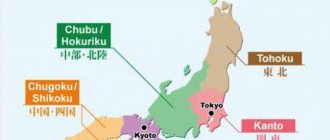The modern world community knows Japan as a country of unique man-made discoveries, unusual geographical location, capricious climate and wise and educated inhabitants. The fate of the country, located in the waters of the Pacific Ocean on the Japanese archipelago, neighboring China, Russia and South and North Korea, is now being decided in the capital of the state, Tokyo, a city that gives shelter to almost 30 million Japanese. Not every inhabitant of our planet knows that this country has changed more than 10 capitals throughout the history of its existence. One of the most interesting was the first capital of Japan.
History of the Land of the Rising Sun
The first mention of Japan appeared in Chinese writings in the 1st century AD. e. Residents of China, looking towards the east in the morning, where the small island state was located, invariably saw the same picture: a fireball rising into the sky.
At that time, the future great power Japan was completely subordinate to the more developed and civilized China. But the country had an amazingly persistent and patient character; soon the Yamato clan, ruling here, caught up and overtook its neighbor, and by the 5th century the word “Yamato” became the personification and synonym for all of Japan.
The centralization of power began, the country was rapidly building roads, Buddhist temples, palaces for Japanese princes, and science and culture were developing. In 645 AD e. During the next palace coup, an important land reform was carried out: now the entire country belonged to the ruler’s family and the state.
The top rulers faced the immediate question of choosing the main place for their residence. The first capital of Japan, the city of Heijō-kyo, which translated into Russian sounds like “Citadel of the World,” was chosen as the most suitable place for this.
Legal Description
Although Tokyo is considered the capital of Japan, there is no law in the country that explicitly grants Tokyo this right. Therefore, Tokyo is considered the de facto capital and not the de jure capital of Japan.
Views: 4,277
Share link:
- Tweet
- Share posts on Tumblr
- Telegram
- More
- by email
- Seal
Liked this:
Like
Emperor's residence on the island of Honshu
A lot of time has passed since the founding of the imperial residence in the city of Heijō-kyo in 710. For 74 years, the entire basic life of the royal family and the territory under its control depended on the decisions that were born in the imperial palace. The structure of the ancient capital of the Land of the Rising Sun was largely subordinated to the traditions of China. A wide road began its journey from the palace of the supreme rulers; residences for the emperor’s vassals, temple complexes, Buddha sculptures and other monuments of oriental architecture were built in an important settlement for the country.
What was the first capital of Japan famous for?
The name Heijō-kyō is very ancient. This city quickly became a key political and cultural center. Here they sacredly revered the Chinese “rules of life”, worked hard and painstakingly, leaving free time to pray to the almighty Buddha for a future happy and prosperous life.
During this period of unprecedented rapid prosperity of the capital, real masterpieces of religious art were created:
- the Todai-ji temple ensemble and its bronze giant - a sculpture of Buddha weighing almost 500 tons;
- wooden temple Daibutsuden;
- the collection of treasures of the widow of Emperor Shomu, which she donated to the Buddhist temple;
- The southern gate of the Todai-ji complex and its fierce 8-meter guards.
The small Japanese town was very lucky; it was the main city of the country for less than 100 years, but for the rest of its life it received legendary world fame.
What is the first capital of Japan known for now?
On the island of Honshu, among green fields, small hills and dense forests, on the southern shore of Lake Biwa, the small town of Nara lives and is still alive in the pristine splendor of precise architectural and geometric proportions. This is what the very first capital of Japan is now called. Millions of curious tourists from all over the world come every year to admire this legendary place for the country. Those who are lucky enough to visit here will be given a unique opportunity:
- look into your own soul in the serene peace of Toshodaiji Monastery and leave its walls completely freed from heavy internal doubts;
- experience the magic of the collection of deity statues in the “Temple of Prosperity of Law”;
- become happy by touching the Miroku-bosatsu sculpture in Kofuji’s “Shrine that Generates Happiness”;
- feed cookies to the “sacred deer” of Nara in the city’s park area;
- enjoy natural landscapes, because this is a place where centuries-old monuments coexist harmoniously with clean ponds, forested areas, mountains, and corners of nature almost untouched by man.
The first capital of Japan - a pretty ancient Japanese town that keeps the magical secrets of the emperors of the Land of the Rising Sun, will forever remain in the hearts of everyone who comes here to touch the centuries-old history of the powerful eastern power.
The ancient capital of Japan is Kyoto. Part I
Today we will continue our journey through Japan and visit its old capital, the city of Kyoto.
Kyoto was founded in 792-794, in 794-1192 it was called Heian. Until 1868 (for 1074 years), Kyoto was officially considered the capital and residence of the emperors. For religious reasons, the imperial residence was moved to another place with each new ruler. In 784, Emperor Kammu (781-806) and the powerful Fujiwara family, which had come to power, planned to move the country's capital to the area of modern Kyoto from the neighboring city of Nara, the first capital of Japan. The village of Uda in Kadono County was chosen for the construction of the new capital. Initially, this place was called Heian-kyo - “Capital of Peace and Tranquility.” In 793, a new city began to be built here according to Chinese models of urban planning. The city had the shape of a rectangle strictly oriented to the cardinal points. In the center was the imperial palace, from which an 80 m wide avenue stretched, dividing the capital into eastern and western halves. Avenues straight as arrows intersected wide streets at right angles. The streets were not given any names, they were simply numbered, starting from the north, where the extensive palace quarter was located. It was not possible to fully implement the grandiose project. The city gradually expanded and was built up with palaces, temples, monasteries, craft workshops and shops. The monasteries around Heian turned it into a major religious center. The city remained the center of spiritual and political life from 794 to 1185 (Heian period). The 11th century, which is called the golden century, especially stands out in the history of Kyoto: it was at that time that world-famous works of Japanese classical literature were written - “The Tale of Genji” by Murasaki Shikibu and “Notes at the Bedside” by Sei Senagon. In 1177, Heian burned to the ground and was rebuilt, and soon renamed Kyoto (“Capital City”). But the residence of the shoguns from the Minamoto clan moved to Kamakura (another city that was the capital). In 1333, the Ashikaga moved the capital again to Kyoto (north of the old center of Heian, in the Muromachi region), and the Muromachi period began (1333-1573). The city repeatedly became a victim of endless internecine strife between various princely clans. In 1569 it was conquered by Oda Nobunaga. Nobunaga and his successor Toyotomi Hideyoshi spared no expense in rebuilding the city. In 1868, the capital of Japan was officially moved from Kyoto to Tokyo.
Kyoto has about 2,000 temples (17 of which are under UNESCO protection), hundreds of parks, and dozens of ancient palaces. The unique harmony of all its many buildings with the surrounding landscape gives a special charm to Kyoto. Temples and palaces seem to grow out of the waters of lakes and hillsides, only emphasizing the natural beauty of the landscape. These places are considered the highest phase in the development of Japanese mastery of “merging with nature.”
Kinkakuji Temple - Golden Pavilion
The Golden Pavilion was built in 1397 at the behest of Shogun Yoshimitsu of the Ashikaga dynasty, where he spent the last years of his life, having lost all interest in the political life of the country. Having retired with his closest friends in this “golden tower”, he indulged in philosophical reflection, enjoyed the tea ceremony and became familiar with the secrets of the Buddhist religion.
After the death of Shogun Yoshimitsu, his son turned Kinkakuji into a Buddhist temple - such was the will of his father. From the rich palace complex, only one Golden Pavilion remains - now a National Treasure of Japan.
Kyomizudera Temple - Temple of Pure Water
The main attraction of the temple is the huge veranda, which protrudes 12 meters above the edge of the cliff where the temple is located. It is supported by huge pillars, fastened together without a single nail. This is a wonderful observation deck and is always crowded. It was once used as a dance stage.
Not a single person who comes to the temple passes the ritual waterfall, to the clear water of which the temple owes its name. The waterfall is guarded by the deity Fudo myo, who scares away evil spirits with his repulsive appearance. Many people perform the ritual of ablution with this water, offering prayers to Fudo myo. This cleansing ritual promises enlightenment to the soul, and the good spirit of the goddess Kannon will bring a feeling of peace and tranquility, a sense of unity with her.
Nijo-jo Castle
Nijo-jo Castle began construction in 1603 as the official residence of the Tokugawa shoguns during their visits to Kyoto. Nijo Castle was built not far from the imperial palace, which was done deliberately. Nijo, with its monumentality, demonstrated the power and might of the Tokugawa house; it surpassed the imperial palace in both space and beauty. With his greatness, he was supposed to dispel any doubts about the inviolability of the power of the shoguns of the Tokugawa house.
The entire palace is decorated in classic Japanese style: the floor is covered with tatami, each room has only three walls, there is no fourth, which should separate the room from the corridor. More precisely, it is not a wall, but light sliding doors. The space between the ceiling and the upper door frame is decorated with rich carved ornaments with peacocks, various animals and plants. The annoying shine of gold is softened by time and the whitish twilight into which white Japanese paper turns daylight. This paper is stretched over wooden sliding frames that make up one long wall of the corridor and at the same time the outer wall of the palace. On hot summer days, you can slide these doors wide open, and then the enclosed space turns into a veranda, which offers views of one of the most beautiful gardens in Japan - Ninomaru Garden.
Ginkakuji Temple - Silver Pavilion
The Silver Pavilion has an exceptional place in the history of Japanese culture. Its architecture, the principles of organizing living space, the combination of home and garden, associated with the philosophical and aesthetic ideas of Zen Buddhism, mark a new stage in the development of Japanese art.
The Silver Pavilion, one of Japan's greatest treasures. The pavilion amazes with its beauty, but not sparkling, but hidden, deep, delights with its soft and at the same time clear outlines, repeated on the mirror surface of the nearby lake.
Ryoanji Garden.
The Ryoanji rock garden is created in a style called “dry landscape” - kare-sansui. On a well-groomed area of light gray gravel leveled with a rake, large boulders and small stones bordered with moss are scattered. The originality of the situation lies in the fact that fifteen black-brown stones of different sizes are placed in such a way that only fourteen of them can be seen at a time. Whichever way you look at them. There are rumors that you can see all fifteen stones at the same time only if you achieve enlightenment through meditation. The first impression that appears from contemplation is a minimum of objects and a monotonous color scheme, it seems that everything is ordinary. But, despite the crowds of tourists, after a while something imperceptibly changes in a person’s state of mind. And now the pain and resentment disappear, the sounds are muffled, and you don’t want to make any decisions. There comes peace and a desire to prolong this state.
A lot of questions arise: what is contained in these stones, why do they have such an effect on people? For almost five centuries, pilgrims from many countries have come to the Ryoanji rock garden, and tourists come here from all over the world. The secret meaning embedded in them has helped the monks of the temple in meditation for many centuries. Every time the garden gives people who come here new sensations and makes them look deep into themselves. Every time you can see new beauty here - constant and at the same time elusive. Trying to unravel the mysteries and admire the garden, you need to sit on the veranda. Everyone who comes to Ryoanji tries unsuccessfully to find the point from which all fifteen stones will be revealed to their eyes. But all of them, in the end, are forced to admit powerlessness. In the stones themselves, everyone sees something different: some see a mountain landscape, others see islands in the sea or floating clouds.
The Buddhist monk Soami, the creator of the Zen garden, gives us a good lesson in understanding ourselves and the world: sometimes it is impossible to know the truth, but it is worth trying. Scientists at Kyoto University conducted a topographic computer analysis. He showed that the stones in the garden area are not located at all chaotically, as expected, but represent a pattern of tree bark invisible at first glance. Why is the number of stones exactly equal to fifteen? The Japanese say that this number symbolizes the full moon, and that after the full moon comes the time of decay. Maybe this is the reason that one stone always remains below the line of visibility?
The Ryoanji rock garden characterizes the Japanese attitude to life, their philosophy, which was developed in the seventh century, and which they adhere to to this day: “One person considers it good, and another thinks it is bad. But one of them is not necessarily a wise man, and the other is a fool. They are both ordinary people." Behind the low adobe fence of the garden are lush tree crowns, which are designed to emphasize the severity of the rock garden. Leaving the mysterious and tranquil stone garden, you can take a walk through the magnificent park located on the territory of the monastery. The park is especially delightful in the spring, during the “plum rains” and on autumn days, when the Japanese maples put on orange, yellow and red clothes. When you enter the temple, you will see a stone vessel for washing your hands. There is an inscription carved on it: “I know only what is necessary.”
This is where we will finish our introductory tour today, and tomorrow we will walk through the streets of modern Kyoto.
PS I recommend that everyone who hasn’t read it read an excellent story about Japan by our journalist Vladimir Tsvetov, you can look for the book, or you can read it here - https://oldgazette.ru/lib/zvetov/reandzi/index.html
